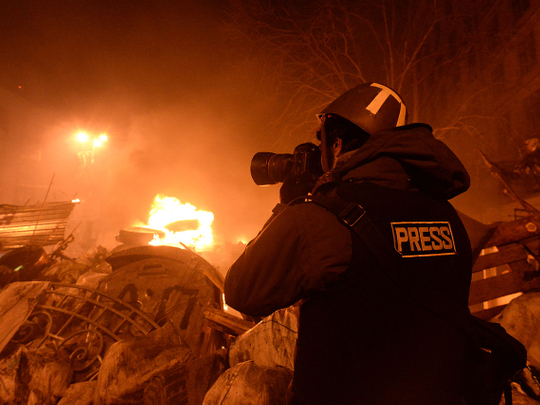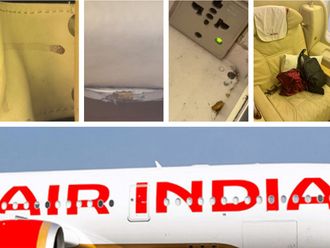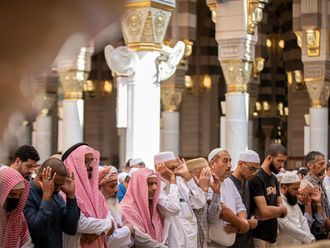
"No worry man, I am here," Agence France-Presse photographer Shah Marai told a collegue who was running late on WhatsApp, in a message later published by AFP.
Moments later, the second bomb exploded.
Twin bombings in Kabul on Monday killed at least 25 people, including nine journalists. It was the deadliest single attack involving journalists in Afghanistan since at least 2002, and one of the most lethal ever worldwide, according to the Committee to Protect Journalists. A 10th journalist, from the BBC's Afghan service, was shot and killed in a separate attack Monday outside Kabul.
Incidentally, World Press Freedom Day falls on May 3.
The bombings were the latest spasm of a conflict that began more than a decade and a half ago and shows no sign of ebbing.
In a two-stage attack, bombers detonated a first device during the morning rush and a second roughly 40 minutes later, killing emergency workers and journalists who had by then reached the site, officials said. A spokesman for the Afghan police, Hashmat Stanikzai, said the attacks in Kabul on Monday had killed at least 25 people, including four policemen, and wounded 49, but officials and witnesses at the scene said the final casualty figures were likely to be higher.
At least nine journalists died, including Marai, who had covered his war-torn homeland for 20 years.
The Afghan government said in a statement that the bombings constituted an attack on Islam and described the targeting of journalists as "an unforgivable crime."
According to Stanikzai of the Afghan police, the chaos Monday began at 8 a.m., when a bomber on a motorcycle blew himself up in the Shah Darak district of central Kabul. The attack took place near a guarded street behind the U.S. Embassy that leads to many offices, including those of the Afghan intelligence agency.
The second explosion, which was described as considerably larger, hit as emergency workers gathered near the police cordon blocking the area.
The second bomber was disguised as a photographer.
"The second explosion was big, and it was among the crowd, like reporters and government staff who were waiting to go to the office," said Muhammad Yunus, 38, a witness. "I was very close to the second explosion; I saw dozens of bodies laying on the ground."
Four broadcasters for Afghan news outlets were also killed, according to Nai, an Afghan nongovernmental organisation working on media freedom. Radio Free Europe later said three of its current or future employees had died, bringing the total news media death toll to nine.
One of those killed, Yar Mohammad Tokhi, a 54-year-old cameraman for Tolonews, was due to be married this month, said a friend and former colleague, Rateb Noori.
A second casualty, Abadullah Hanazai, a 28-year-old reporter for RFE/RL in Kabul, was his family's main breadwinner, and had been married just seven months, according to his colleague Ebrahim Safi.
The BBC announced that a 10th journalist - a 29-year-old reporter for the BBC Afghan service, Ahmad Shah - had been shot in a separate attack in Khost province by unknown gunmen.
- Inputs from New York Times
Being a journalist in Pakistan: Shafqat Ali
"Pakistan is described as one of the deadliest countries to practice journalism by the global rights organizations as every year so many journalists are killed in the line of duty.
Being a journalist is relatively easy in Islamabad when compared to other cities, especially in Balochistan, tribal belt and rural Sindh but it still cannot be termed the best option for fresh graduates.
Since I worked most of them time during my 21-year career in Islamabad there have been lesser threats but the road has never been clear to drive smoothly.
Whenever I did some exclusive or tried to dig an investigative story, I found out that I was being ‘watched.’ And at certain times, I was contacted for so-called briefings although the stories were available online and in the newspapers. Receiving unexpected calls is enough to make you feel insecure. And ‘surprise meetings’ add to the pressure.
There are red-lines set by the government, the political parties, the religious parties and organizations which, when crossed, get a response. Luckily I have never been kidnapped or over-harassed but stepping out of the house and saying good-bye to your loved ones – who expect you to come back in the evening – is still never easy.
There has been times when I was told by my family to leave the profession and find some pother suitable job or do business. I found the easy way out – don’t go too far and try to inform your audience rather than attempting to sensationalize the issue which may be ‘unacceptable.’
However, there have been times when my car was stopped to politely tell me “why you are chasing this story.” Lucky me! Some friends were delivered the same message in harsher ways.
Since you know somebody is watching, you never get to open your arms and play freely. The journalists have also learned how to play the game. Most of them try not to touch the ‘touchy’ subjects. And others make sure the story is not ‘too exclusive.’
Despite all the care, the insecurity element refuses to fade away. Every day is a new challenge. Should I do this? Or should I re-angle it?
The politicians are as insecure but several of them have personal or official security. As a journalist, I walk out of my place thinking about myself and other friends’ safety. I drive, recalling the tales narrated by friends and file the story hoping to stay out of trouble.
Every Pakistan government has been making tall claims about protecting the journalists but deaths have occurred, media persons have been wounded, they have been kidnapped and harassed, even in Islamabad.
The bitter part of the whole story is that majority of the harassment comes from non-state actors who do not want the journalists to expose their ‘deeds.’
Having said all this, I believe it is easier to work in Islamabad than in far-flung cities, influenced by the religious groups and feudal lords. The government does give you a decent liberty to work."
Oppressed Palestinian journalists
In just five weeks, two Palestinian journalists have been killed by Israeli snipers and at least 12 others were injured.
Palestinian reporters are accusing Israel of “deliberately” targeting them, while International criticism of Israeli tactics towards reporters has been growing, saying they are using heavy arms.
The Committee to Protect Journalists have issued a report this month that it has seen a marked increase in the number of violations against Palestinian reporters in April alone, compared to last month. It have recorded 130 violations by the Israeli army.
The report pointed out that the Israeli occupation has targeted 84 journalist during the month of April in the Gaza Strip. While in March 82 journalists, including 14 female journalists, were targeted with live ammunition, resulting in the death of Moussa Samhan and Ahmed Abu Hussain. Journalist Yousuf Al Karnaz’s leg had to be amputated.
Four broadcast vehicles were also destroyed.
Israeli occupying forces arrested also two journalists, Mousa Samhan from and Manal Al Ja'bari, and one media student Ola Marshoud last month.
By Sara Al Shurafa, Web News Editor
Facts and Stats
While the world decries the attacks that claimed the lives of 10 journalists – who were part of the dozens of deaths recorded – in Afghanistan on April 30, the incident is a bloody reminder of what a journalist’s job entails.
Bombs and bullets, hatches and machetes – if you are a reporter and on the front lines the odds of you facing someone wielding a weapon of destruction are quite high. From death in cross-fire to targeted attacks and murder, being a reporter in a war zone or media-averse country is life-threatening.
While fear ripples along with the dust when life-threatening blasts occur, they brave not only the possibility of being crippled but also of never seeing their families again.
Which is the worst country to be a journalist in?
This, because the world needs to know the truth. This, because someone has to do the gory job. This, because sometimes there is no choice but to face your fears and in doing so tug on the strings of hope, to call out to allies, to bring respite to those who cannot articulate their troubles as well.
Horrific numbers
This courage however has claimed many, many lives over the years. Here are the numbers compiled by Committee to Protect Journalists (CPJ), a non-profit organisation, of the casualties of war.
A total of 1,290 journalists were between 1992 and 2018, of which the most died in 2009 (76). 164 journalists in this list have been killed over the years while on dangerous assignments, while 58 are missing.
CPJ, in this list, looked at both freelance and staff journalists who died during or because of their jobs. The causes of death included are murder, death in cross-fire or combat and dangerous assignments. These are the number of journalists killed in line of work from 1992 to 2018:
| 1992 | 94 |
| 1993 | 56 |
| 1994 | 66 |
| 1995 | 51 |
| 1996 | 26 |
| 1997 | 26 |
| 1998 | 24 |
| 1999 | 36 |
| 2000 | 24 |
| 2001 | 37 |
| 2002 | 21 |
| 2003 | 42 |
| 2004 | 61 |
| 2005 | 50 |
| 2006 | 57 |
| 2007 | 70 |
| 2008 | 42 |
| 2009 | 76 |
| 2010 | 42 |
| 2011 | 48 |
| 2012 | 74 |
| 2013 | 73 |
| 2014 | 61 |
| 2015 | 73 |
| 2016 | 48 |
| 2017 | 46 |
| 2018 | 14 |
At least 35 journalists have been killed in direct relation to their work in Afghanistan since 1992, according to CPJ research.
World Press Freedom
According to the 2018 World Press Freedom Index, compiled by Reporters Without Borders (RSF), targeted attacks and hostility towards media workers and journalists is on the rise. Published annually by RSF since 2002, the World Press Freedom Index measures the level of media freedom in 180 countries.
Scroll ► ► ►
The 2018 report shows that many elected leaders of democracies see media, not as an essential part of society and sovereignty, but as ‘enemies of the people’ as termed by Donald Trump, US president. Verbal insults and bashing aside, journalists are at increasingly high risk of physical harm as well.
Best and worst
In this year’s index, Norway is first for the second year running as the best for free reporting by journalists and press workers. Unsurprisingly, North Korea has been in the last position for two years, categorised as the worst place for press freedom. Even though Norway and Sweden, among other Nordic nations, rank high, the global decline in press freedom has affected these countries as well.
Red regions
The map on media freedom released by RSF is largely red, categorised as ‘bad’ for journalists. 27 per cent of countries studied fall in this category. Russia, the largest country in the world, dominates the red zone, which includes countries such as India, Pakistan, Afghanistan, Philippines, Kazakhstan, Algeria, Mexico, Columbia and Venezuela.
Black holes
There have never been more countries in the ‘black’ coloured box than in 2018 (22), which denote countries that are news and information black holes. These are at the very bottom of the index where the situation is classified as “very bad”. These are the worst ranked of the list:
| 159 | Burundi |
| 160 | Iraq |
| 161 | Egypt |
| 162 | Libya |
| 163 | Azerbaijan |
| 164 | Iran |
| 165 | Uzbekistan |
| 166 | Bahrain |
| 167 | Yemen |
| 168 | Somalia |
| 169 | Saudi Arabia |
| 170 | Laos |
| 171 | Equatorial Guinea |
| 172 | Cuba |
| 173 | Djibouti |
| 174 | Sudan |
| 175 | Vietnam |
| 176 | China |
| 177 | Syria |
| 178 | Turkmenistan |
| 179 | Eritrea |
| 180 | North Korea |
According to the indicators used to measure the annual changes, it is the Mena region that has registered the biggest decline in media freedom in 2018.
Shafqat Ali, a journalist from Islamabad, talks field experience
"Pakistan is described as one of the deadliest countries to practice journalism by the global rights organisations as every year so many journalists are killed in the line of duty.
Being a journalist is relatively easy in Islamabad when compared to other cities, especially in Balochistan, tribal belt and rural Sindh, but it still cannot be termed the best option for fresh graduates.
Since I worked [in] most of them [the places] during my 21-year career in Islamabad there have been lesser threats but the road has never been clear to drive smoothly.
Whenever I did an exclusive or tried to dig [into] an investigative story, I found out that I was being ‘watched’. And at certain times, I was contacted for so-called briefings although the stories were available online and in newspapers. Receiving unexpected calls is enough to make you feel insecure. And ‘surprise meetings’ add to that pressure.
There are red-lines set by the government, the political parties, the religious parties and organisations which, when crossed, get a response. Luckily I have never been kidnapped or over-harassed but stepping out of the house and saying goodbye to your loved ones – who expect you to come back in the evening – is still never easy.
There have been times when I was told by my family to leave the profession and find some other suitable job, or do [some] business. I found the easy way out – don’t go too far and try to inform your audience rather than attempting to sensationalise the issue, which may be ‘unacceptable.’
However, there have been times when my car was stopped to politely [ask] me “why you are chasing this story?” Lucky me! Some friends were delivered the same message in harsher ways.
Since you know somebody is watching, you never get to open your arms and play freely. The journalists have also learned how to play the game. Most of them try not to touch the ‘touchy’ subjects. And others make sure the story is not ‘too exclusive.’
Despite all the care, the insecurity element refuses to fade away. Every day is a new challenge. Should I do this? Or should I re-angle it?
The politicians are as insecure but several of them have personal or official security. As a journalist, I walk out of my place thinking about myself and other friends’ safety. I drive, recalling the tales narrated by friends and file the story hoping to stay out of trouble.
Every Pakistan government has been making tall claims about protecting the journalists but deaths have occurred, media persons have been wounded, they have been kidnapped and harassed, even in Islamabad.
The bitter part of the whole story is that majority of the harassment comes from non-state actors who do not want the journalists to expose their ‘deeds.’
Having said all this, I believe it is easier to work in Islamabad than in far-flung cities, influenced by the religious groups and feudal lords. The government does give you a decent liberty to work.
The toll it took to live on the front lines
Here's a look at four journalists who died while on the job.
The man who saw too much
Kevin Carter: September 13,1960 –July 27, 1994
Current ranking of country of death in the Reporters without Borders report: 28
There are things you see on the job, when on the front lines, that won’t go away even in the darkness, even when you close your eyes.
Carter, a Pulitzer-winning photojournalist who was part of a team that included the talented Greg Marinovich, Ken Oosterbroek and Joao Silva, was forever scarred by what he saw while reporting the demise of apartheid. The second-generation Irishman was focused on a South Africa teeming with violence and lacking in stability.
He started off as a photographer in 1983, and went on to become the first to document necklacing – a practice where rubber tires filled with petrol are used to confine and burn a person alive.
And while the images he took – including the gut-wrenching vulture and little girl - resounded with the world and called it to action, they also created a pit of despair around him. He ended up killing himself at the age of 33.
“I am depressed ... without phone ... money for rent ... money for child support ... money for debts ... money!!! ... I am haunted by the vivid memories of killings and corpses and anger and pain ... of starving or wounded children, of trigger-happy madmen, often police, of killer executioners ... I have gone to join Ken if I am that lucky.”
– From Kevin Carter’s suicide note
Captured, tortured and killed
James Wright Foley: October 18, 1973 – August 19, 2014
Current ranking of country of death in the Reporters without Borders report: 177
An American journalist and video reporter’s plight had the world on tenterhooks. On assignment as a freelance correspondent during the Syrian Civil War, Foley often found himself in areas where it rained bullets instead of water. Foley, who began his career as a teacher before committing to journalism, had reported extensively in Syria before he was captured by Daesh in 2012.
After being held by the terrorist organisation for about two years, he was executed on videotape, apparently as a rebuff of then US President Barack Obama’s Iraq strikes.
John Cantlie, another captive, revealed Foley’s final words minutes before he was beheaded.
“Great, captured on Thanksgiving Day, killed on my mum’s birthday”, according to The Sun.
Shot outside her house
Gauri Lankesh: January 29, 1962 –September 5, 2017
Current ranking of country of death in the Reporters without Borders report: 138
It seems like something out of a horror film. Lankesh, an Indian journalist-turned-activist from Bengaluru, Karnataka, was known for being an outspoken critic of Hindu right-wing Hindu extremism. On that fateful day, at 8pm, when Lankesh returned home from office – she was the editor of the weeklies Lankesh Patrike and Gauri Lankesh Patrike – she found herself the target of three gunmen who shot at her seven times. Three of those bullets traced a bloody line through Gauri's head, neck, and chest, killing her on the scene.
At the time of her death, Gauri was known for being a critic of right-wing Hindu extremism. She was posthumously accorded the Anna Politkovskaya Award, which was established in honour of the brave journalist with the same name who was murdered in 2006 while reporting on second war in Chechnya.
She was particularly concerned about polarisation among journalists. A day before she died, the prolific journalist tweeted: “Why do I feel that some of `us' are fighting between ourselves? We all know our “biggest enemy”. Can we all please concentrate on that?”
Attacked minutes away from military headquarters
Anjum Muneer Raja
For 40-year-old Raja just riding home turned into a battle for his life. Driving down Bank Road, Rawalpindi, minutes away from military’s national headquarters, the sub editor found himself surrounded by bikers who opened fire.
Shot six times - in the head, neck and torso – the father of one died at the scene; the attackers fled.
Last year, prominent reporter Ahmed Noorani was also savagely beaten and stabbed in the head after being dragged out of his car in Islamabad by armed assailants.
Pakistan is among the most dangerous countries in the world for journalism, Reporters Without Borders (RSF) said in its annual press freedom report last May. This year it’s on number 139.









